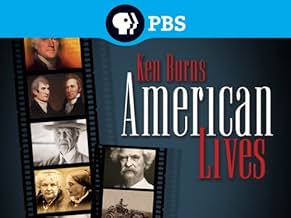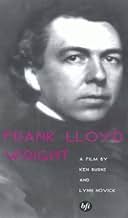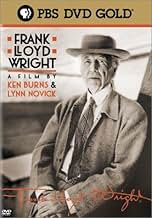Agrega una trama en tu idiomaA biography of the life and work of the American architect.A biography of the life and work of the American architect.A biography of the life and work of the American architect.
- Nominado a 1 premio Primetime Emmy
- 3 premios ganados y 2 nominaciones en total
- Dirección
- Guionista
- Todo el elenco y el equipo
- Producción, taquilla y más en IMDbPro
Opiniones destacadas
Frank Lloyd Wright is the most innovative and influential architect in the 20th century. He shaped the way we think about buildings today, and put architecture at a different level of thinking. Buildings look simple in design but modern in method of the art of architecture. Even if you are an architect or not, you will enjoy this documentary.
I can't help liking a man so devoted to what he perceived as excellence, but it's possible to find his creations less than perfect. They were too costly and impractical and may have started a pernicious trend in architecture: ostentation rather than comfort. Wright seems to forget that buildings are there to serve us, not the other way around. He seems more at home on the stage, as a set designer for futuristic films or operas, rather than the real world. Did he like Beethoven? Well, so do I, and Chausson and Faure too. This is a great documentary about a fascinating man, at war with practicality and mortality.
I think the thing to remember about this documentary is that it's called "Frank Lloyd Wright," not "The Buildings of Frank Lloyd Wright." There are many other resources for those wishing to learn about his designs and the structures he built. (A personal recommendation is the 2002 documentary, "Restoration of Frank Lloyd Wright's Heurtley House").
The format that Ken Burns's films use is well known by now: pans of many still photographs, informative narration -- often jam-packed with facts but clearly presented and in a generally objective tone. Shifts in time and place are smoothly integrated such that it's unlikely that an attentive viewer will get lost.
Frank Lloyd Wright died in 1959 at age 91, and there were very few years in his long life that were not without controversy. He broke all kinds of rules with his architectural designs to create some truly remarkable structures -- "Fallingwater," the Johnson Wax Building in Racine, Wisconsin, the Imperial Hotel in Tokyo and most especially the Guggenheim Museum in New York. They are all examples of his iconoclasm. They and other structures sealed his reputation as the most famous American architect of his or any other generation. But it was the personal scandals, generally involving other men's wives, that forced him to flee the country on a number of occasions, and put his career in a deep freeze for long spells.
By his own admission Wright was an absent and negligent father to his many children; he seems to have been serially unfaithful until late middle age, and he was wild and extravagant with money -- particularly other people's. Clips from a 1958 TV interview with a chain-smoking Mike Wallace are interspersed throughout, and a snippet of it concludes the documentary with Wright proclaiming his immortality. Wright the man seems to have been insufferable, and he seems to have gotten little joy out of life.
Yet his doesn't appear to have been a tortured soul; his personal life may have been absent any harmony, and yet that quality repeatedly found its way into his work. Many of Wright's buildings are in breathtaking concert with nature. His interior designs, including that of the Unity Temple and almost all of his stained glass, suggest they are the creation of an unfettered and free spirit. Wright may have been such a man, but if so he directed those energies in many of the wrong places. His self-centeredness, arrogance and certainty of his genius hurt a lot of people around him.
It's well to ask why anyone wanted to work under him, and yet the waiting list for the scholarship program he operated at his Taliesin West studios in Arizona in the 1930s, 40s and 50s was a mile long. Students of Wright's were bent to his will; they had to do four hours' manual labor a day, grow their own food, submit to having their love relationships and even some marriages orchestrated by his wife, Olgivanna. The place was run like a boot camp, but the opportunity to work side by side with Wright was enough to keep the applications flowing in. Several graduates of the school are interviewed in the documentary, and for all of them working with Wright seems to have been the seminal experience of their lives -- they don't recall the hoops they had to jump through and the indignities they signed on for in order to have that privilege.
To truly love and appreciate the works of Frank Lloyd Wright, it's almost better if you don't know too much about their designer. Still, the dichotomy between the man and his sublime creations makes a great story, and this documentary is a largely successful attempt to bridge that gap.
The format that Ken Burns's films use is well known by now: pans of many still photographs, informative narration -- often jam-packed with facts but clearly presented and in a generally objective tone. Shifts in time and place are smoothly integrated such that it's unlikely that an attentive viewer will get lost.
Frank Lloyd Wright died in 1959 at age 91, and there were very few years in his long life that were not without controversy. He broke all kinds of rules with his architectural designs to create some truly remarkable structures -- "Fallingwater," the Johnson Wax Building in Racine, Wisconsin, the Imperial Hotel in Tokyo and most especially the Guggenheim Museum in New York. They are all examples of his iconoclasm. They and other structures sealed his reputation as the most famous American architect of his or any other generation. But it was the personal scandals, generally involving other men's wives, that forced him to flee the country on a number of occasions, and put his career in a deep freeze for long spells.
By his own admission Wright was an absent and negligent father to his many children; he seems to have been serially unfaithful until late middle age, and he was wild and extravagant with money -- particularly other people's. Clips from a 1958 TV interview with a chain-smoking Mike Wallace are interspersed throughout, and a snippet of it concludes the documentary with Wright proclaiming his immortality. Wright the man seems to have been insufferable, and he seems to have gotten little joy out of life.
Yet his doesn't appear to have been a tortured soul; his personal life may have been absent any harmony, and yet that quality repeatedly found its way into his work. Many of Wright's buildings are in breathtaking concert with nature. His interior designs, including that of the Unity Temple and almost all of his stained glass, suggest they are the creation of an unfettered and free spirit. Wright may have been such a man, but if so he directed those energies in many of the wrong places. His self-centeredness, arrogance and certainty of his genius hurt a lot of people around him.
It's well to ask why anyone wanted to work under him, and yet the waiting list for the scholarship program he operated at his Taliesin West studios in Arizona in the 1930s, 40s and 50s was a mile long. Students of Wright's were bent to his will; they had to do four hours' manual labor a day, grow their own food, submit to having their love relationships and even some marriages orchestrated by his wife, Olgivanna. The place was run like a boot camp, but the opportunity to work side by side with Wright was enough to keep the applications flowing in. Several graduates of the school are interviewed in the documentary, and for all of them working with Wright seems to have been the seminal experience of their lives -- they don't recall the hoops they had to jump through and the indignities they signed on for in order to have that privilege.
To truly love and appreciate the works of Frank Lloyd Wright, it's almost better if you don't know too much about their designer. Still, the dichotomy between the man and his sublime creations makes a great story, and this documentary is a largely successful attempt to bridge that gap.
10OGRE-8
After watching this film I cried knowing that prefection was attainable. For proof all you need do is look at the many buildings that are a testament to Frank Lloyd Wright's immortality.
FLW was not kind to his first two wives and was not much of a father but he is not the only genius who did it his way, he had a vision and he went for it. The documentary shows how Frank Lloyd Wright is a one of a kind personality and a true genius. We come to understand his brilliance and great charisma but also see the side of him that was brash, judgmental, and incredibly arrogant. It does a pretty good job of touching on his work and its principles and his extraordinary career too, but what it does best is to offer an understanding of Wright as a person. It is well done and I enjoyed watching it.
He reminds me of Leonardo, another genius in his field, he had the tenacity to realize his vision and stand out among all others in his field.
After watching this, I went to Youtube and watched the videos of many of his houses and buildings and they just blew me away. Incredible beauty. Not only designed the house,but in many instances,the furniture!
He reminds me of Leonardo, another genius in his field, he had the tenacity to realize his vision and stand out among all others in his field.
After watching this, I went to Youtube and watched the videos of many of his houses and buildings and they just blew me away. Incredible beauty. Not only designed the house,but in many instances,the furniture!
¿Sabías que…?
- TriviaNot counting all the other delinquent bills that Wright left for his wife, the grocery bill alone came to approximately $30,000 in 2022 dollars.
- ConexionesFeatured in Ken Burns: America's Storyteller (2017)
- Bandas sonorasMoonglow
Written by Will Hudson, Edgar De Lange, and Irving Mills
Performed by Benny Goodman and His Orchestra
Courtesy of EMI Music Publishing, Scarsdale Music Corp., and RCA Records Label of BMG Music
Selecciones populares
Inicia sesión para calificar y agrega a la lista de videos para obtener recomendaciones personalizadas
Detalles
- Tiempo de ejecución2 horas 26 minutos
- Color
Contribuir a esta página
Sugiere una edición o agrega el contenido que falta























